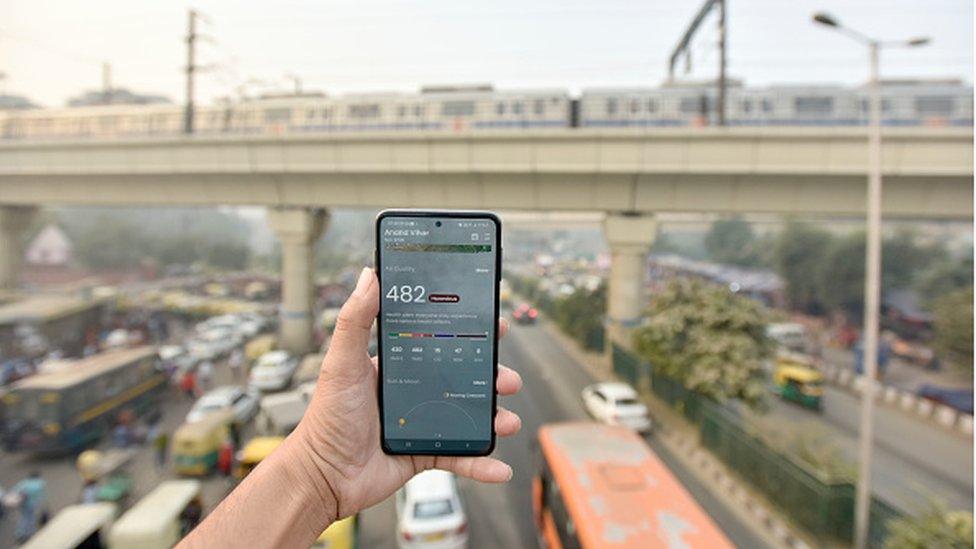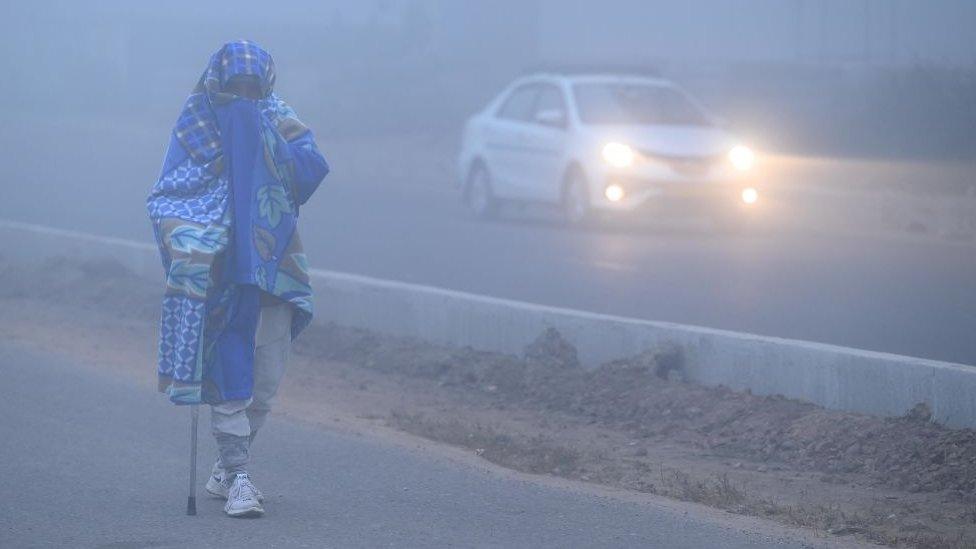Canada wildfire: Delhi’s pollution tips for North America
- Published

Delhi is one of the most polluted cities in the world
Images of the Statue of Liberty in New York - obscured by a thick haze of smoke caused by wildfires in neighbouring Canada - have shocked the United States.
But in the Indian capital Delhi, the iconic India Gate hidden behind a thick haze is a reality every winter.
Smoke from farmers burning crop stubble in neighbouring states mixes with pollutants released by fire crackers that are set off by millions of revellers during the Hindu festival of Diwali.
This produces a thick blanket of smog that covers the city.
The air gets dangerously bad, with pollution reaching levels nearly five times what the World Health Organization considers safe. It is the equivalent of smoking packs of cigarettes a day.
You can feel the pollution on your skin, see it on the horizon - as the skyline turns a sickly grey-yellow - and taste it in your throat.
Residents are implored to stay inside, keep the windows and doors closed and wear masks when stepping out.
It is like a scene from a dystopian novel or an apocalyptic film, except that it is real.
Delhi'ites - as the city's residents are called - start complaining of stuffy noses, burning eyes and pounding heads.
Hospitals begin to fill up with wheezing people with breathing difficulties.
Those who can afford it, rush to buy expensive air purifiers. But these are effective only in closed rooms.
The city and its suburbs, that make up India's national capital region, are home to more than 32 million people, the majority of whom have to get out and about.
The poor who reside in the city's slums and shanties, alongside millions of daily wage workers, roadside vendors and traffic policemen who work outdoors, are condemned to breathe the foul air.
Roadside fires that are started to keep warm as temperatures dip and the nights get colder, also contribute to an increase in the pollution levels.
And as the city routinely tops the list of "world's most polluted capitals", Delhi'ites obsessively check apps that provide a reading of the air quality index.
The levels of PM2.5, the lung-damaging tiny particles in the air that can exacerbate a host of health issues like cancer and cardiac problems, and PM10 - slightly larger particles, but still pretty damaging - are of particular interest.
Levels of PM2.5 below 50 are considered "good" and under 100 "satisfactory".
It is summer now, and there have been occasional days of clear blue skies and bouts of unexpected rainfall.
But the PM2.5 levels in Delhi on Thursday are still hovering around 150 on Safar and other Indian government apps.
On some winter days, they rise to 400 or even breach 500 - the maximum the apps can measure.

The city's Air Quality Index (AQI) levels rise to the severe category during winter
Experts say exposure to such high levels of pollution make people more prone to all kinds of infections - they increase the risk of heart attacks and can damage vital organs like the liver and brain.
A study done by US research group Energy Policy Institute at the University of Chicago (Epic), last year found that air pollution in Delhi can shorten lives by almost a decade.
When things get really unbearable, schools and colleges are shut, construction work is halted and trucks that run on diesel are banned from the city.
Other emergency measure include encouraging people to work from home and curbing the use of private cars.
But critics say these measures are like putting a bandage on a gunshot wound.
So, every year, as the air turns murky, judges of the Indian Supreme Court haul state and federal governments into court, asking them what they intend to do about the problem,
Experts say cleaning up the air requires drastic measures - but they are not a priority for the country's leaders.
BBC News India is now on YouTube. Click here, external to subscribe and watch our documentaries, explainers and features.

Read more India stories from the BBC:

- Published9 January 2023
